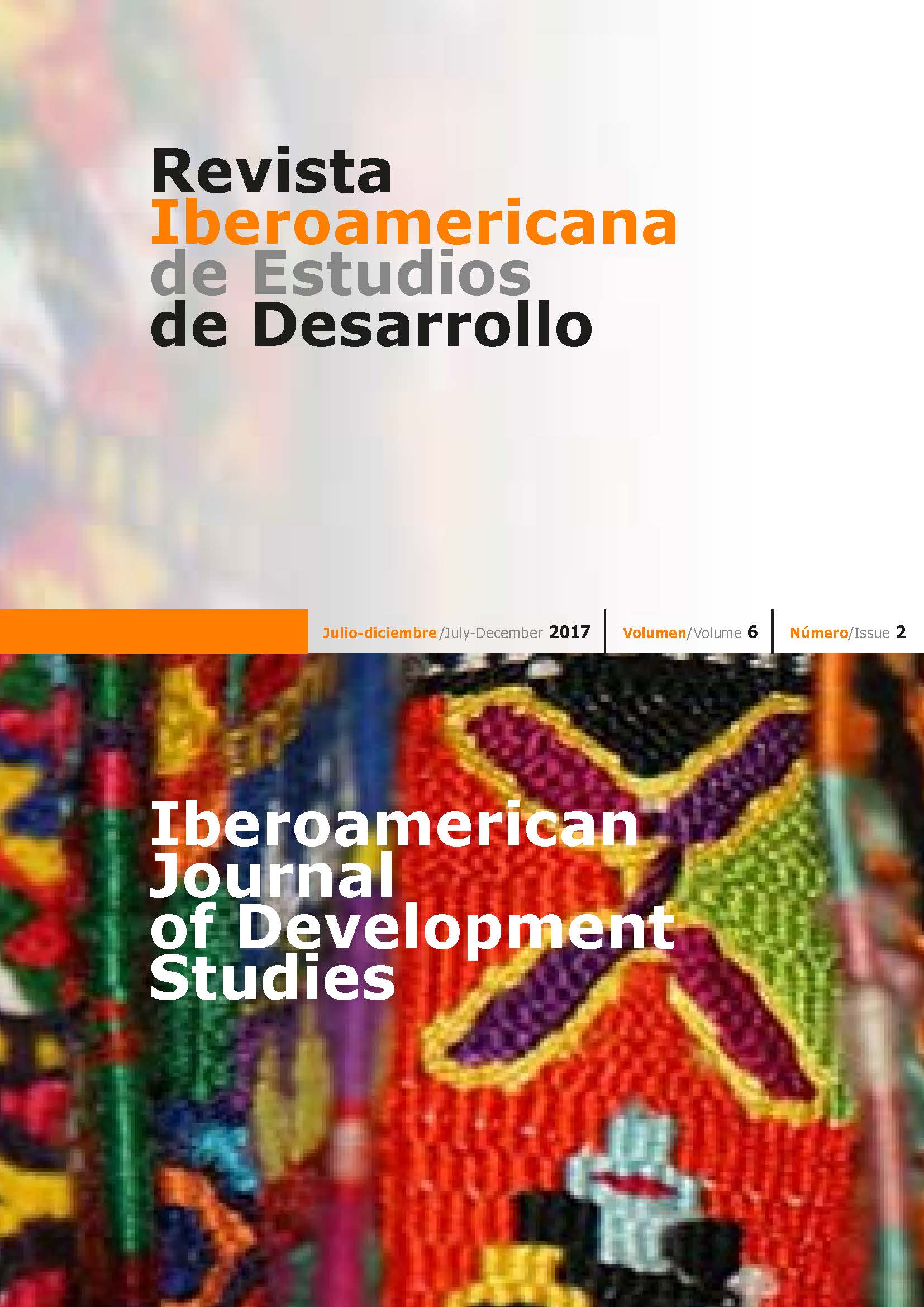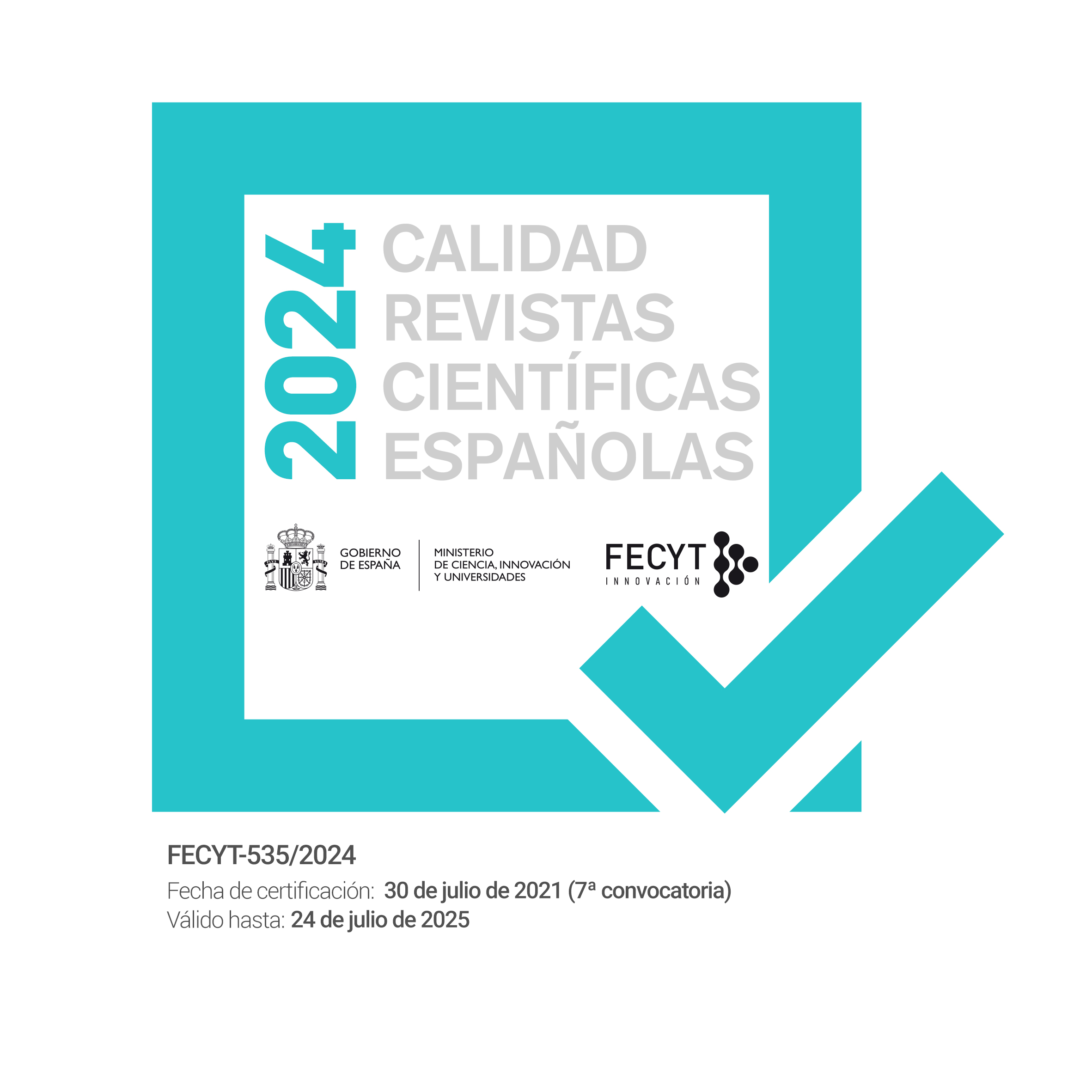El petróleo en Ecuador, 2000-2015: ¿maldición, bendición o simple recurso?
DOI:
https://doi.org/10.26754/ojs_ried/ijds.248Palabras clave:
maldición de recursos, dependencia, cambio estructuralResumen
El petróleo ha representado el principal rubro de exportación de Ecuador desde los años 70 y en la actual coyuntura de bajos precios la diversificación productiva, o cambio estructural, vuelve al centro del debate sobre las estrategias de desarrollo. Este artículo se propone establecer si la dependencia del petróleo ha obstaculizado la diversificación productiva de Ecuador durante el reciente boom de los commodities (2003-2014). Para esto, se caracteriza la llamada tesis de la “maldición de los recursos”, identificando las variables que la literatura establece como sus determinantes y las recomendaciones de política dirigidas a los países ricos en recursos, para luego analizar el caso ecuatoriano y determinar la existencia de una maldición del petróleo en Ecuador. Los hallazgos indican que, si bien dependencia de recursos naturales y la baja diversificación productiva son fenómenos empíricamente asociados, no es posible establecer una relación clara de causalidad entre ellos.
Mostras las descargas
Referencias
ACOSTA A (2011). Extractivismo y neoextractivismo: dos caras de la misma maldición. En: Grupo Permanente de Trabajo sobre Alternativas al Desarrollo. Mas allá del desarrollo. Fundación Rosa Luxemburg y Abya Yala, Quito, pp. 83-118.
ALBUJA V, DÁVALOS P (2013). Extractivismo y posneoliberalismo: el caso de Ecuador. Estudios Críticos del Desarrollo 3(4):83-112.
ALEXEEV M, CONRAD R (2009). The elusive curse of oil. The Review of Economics and Statistics 91(3):586-598.
ARROW K, DASGUPTA P, GOULDER RH, MUMFORD KJ, OLESON K (2012). Sustainability and the Measurement of Wealth. Environment and Development Economics 17:317-335.
ARTOLA V, PAZMIÑO MF (2007). Análisis de los fondos petroleros en el Ecuador. Apuntes de Economía 53. Dirección General de Estudios, Banco Central del Ecuador, Quito.
AUTY RM (1990). Resources-Based Industrialization: Sowing the Oil in Eight Developing Countries. Clarendon Press, Oxford.
AUTY RM (1993). Sustaining Development in Mineral Economies: The Resource Curse Thesis. Routledge, Londres y Nueva York.
BANCO CENTRAL DEL ECUADOR (BCE) (2013). Estadísticas macroeconómicas. Presentación coyuntural. Banco Central del Ecuador, Quito.
BANCO CENTRAL DEL ECUADOR (BCE) (2016). Estadísticas macroeconómicas. Presentación estructural. Banco Central del Ecuador, Quito.
BATTAILE B Y MISHRA S (2015). Transforming Non-Renewable Resources Economies. Working Papers 15/171. FMI, Washington.
BEBBINGTON A (2015). Political Ecologies of Resources Extraction: Agendas Pendientes. European Review of Latin American and Caribbean Studies 100:85-98.
BLEANEY M, HALLAND H (2016). Do Resource-Rich Countries Suffer from a Lack of Fiscal Discipline? Policy Research Working Paper 7552. The World Bank, Washington.
BRESSER-PEREIRA CL (2008). The Dutch disease and its neutralization: a Ricardian approach. Brazilian Journal of Political Economy 28(1):47-71.
BRUNNSCHWEILER C, BULTE E (2009). Natural resources and violent conflict: resource abundance, dependence, and the onset of civil wars. Oxford Economic Papers 61:651-674.
CABRALES A, HAUK E (2010). The quality of political institutions and the curse of natural resources. The Economic Journal 121:58-88.
CASANOVA C, XIA L, FERREIRA R (2015). Measuring Latin America’s export dependency on China. BBVA Research Working Paper 15/26.
CAVALCANTI TV, MOHADDES K, RAISSI M (2012). Commodity Price Volatility and the Sources of Growth. Working Papers 12/12. FMI, Washington.
CEPAL (2011). Panorama de la inserción internacional de América Latina y el Caribe 2010-2011. La región en la década de las economías emergentes. Cepal, Santiago de Chile.
CEPAL (2014). Panorama de la inserción internacional de América Latina y el Caribe 2014. Integración regional y cadenas de valor en un escenario externo desafiante. Cepal, Santiago de Chile.
CEPAL (2015). Panorama Fiscal de América Latina y el Caribe 2015. Dilemas y espacios de políticas. Cepal, Santiago de Chile.
CEPAL (2016). Panorama Fiscal de América Latina y el Caribe 2016. Las finanzas públicas ante el desafío de conciliar austeridad con crecimiento e igualdad. Cepal, Santiago de Chile.
CHANG HJ (2010). Institutions and economic development: theory, policy and history. Journal of Institutional Economics 7(4):473-498.
CORDEN WM, NEARY JP (1982). Booming sector and de-industrialization in a small open economy. The Economic Journal 92:825-848.
CORI A, MONNI S (2014). The Resource Course Hypothesis: Evidence from Ecuador. SEEDS Working Paper Series 28/2014.
CORNELL UNIVERSITY, INSEAD, WIPO (2013). The Global Innovation Index 2013: The Local Dynamics of Innovation. Cornell University, Insead y WIPO. Ginebra, Ithaca y Fontainebleau.
CUNHA AM, BICHARA J, LÉLIS MT (2013). América Latina y el Ascenso de China: una perspectiva desde Brasil. América Latina Hoy 65:185-207.
CYPHER JM (2009). ¿Vuelta al siglo XX? El auge de las materias primas y el proceso de «primarización» en América Latina. Foro Internacional 49-1(195):119-162.
DABLA-NORRIS E, ALUN HT, GARCIA-VERDU R, CHEN Y (2013). Benchamarking Structural Transformation Across the World. Working Paper 13/176. FMI, Washington.
DÍAZ-ALEJANDRO C (1988). ¿Economía abierta o economía cerrada? El trimestre Económico 50(171-1):207-243.
DOMÍNGUEZ R (2009). Staple theory y crecimiento liderado por las exportaciones. México en el contexto norte y latinoamericano. En: Romero ME, Carrillo A (coords.). Empresa y agricultura comercial en el Noroeste de México. Historia económica y tendencias actuales. UNAM, México, pp. 421-457.
FELIPE J, ABDON A, KUMAR U (2012). Tracking the Middle-income Trap: What Is It, Who Is in It, and Why? Levy Economics Institute Working Paper 715.
FMI (2012). Macroeconomic Policy Framework for Resource-Rich Developing Countries. FMI, Washington.
FRANKEL JA (2012). The Natural Resource Curse: A Survey of Diagnoses and Some Prescriptions. Faculty Research Working Paper Series 12-014. John F. Kennedy School of Government at Harvard University, Cambridge (MA).
GILBERTHORPE E, RAJAK D (2016). The Anthropology of Extraction: Critical Perspectives on the Resource Curse. Journal of Development Studies, en prensa.
GUDYNAS E (2009). Diez tesis urgentes sobre el nuevo extractivismo. En: Schuldt J et al. Extractivismo, política y sociedad. CAAP y Claes, Quito, pp. 187-225.
HARDING T, VENABLES A (2013). The Implications of Natural Resources Exports for Non-Resource Trade. Research Paper 103. Oxford Centre for Analysis of Resource Rich Economies, Oxford.
HARVEY D, KELLARD NM, MADSEN JB, WOHAR ME (2010). The Prebisch-Singer hypothesis: four centuries of evidence. The Review of Economics and Statistics 92(2):367-377.
HAUSMANN R, KLINGER B (2006). Structural Transformation and Patterns of Comparative Advantage in the Product Space. Working Paper 128. Center for International Development at Harvard University, Cambridge (MA).
HAUSMANN R, KLINGER B (2010). Structural Transformation in Ecuador. Policy Brief, IDB-PB-112, Caracas.
HAVRANEK T, HORVATH R, ZEYNALOV A (2016). Natural Resources and Economic Growth: A Meta-Analysis. World Development, en prensa.
HUMPHREYS M, SANDBU M (2007). The Political Economy of Natural Resource. En: Humphreys M. et al. (eds.). Escaping the Resources Curse. Columbia University Press, Nueva York, pp. 194-234.
HUMPHREYS M, SACHS JD, STIGLITZ JE (2007). Future directions for the Management of Natural Resources. En: Humphreys M et al. (eds.). Escaping the Resources Curse. Columbia University Press, Nueva York, pp. 322-336.
KAHATT FK (2013). Las industrias extractivas y sus implicaciones políticas y económicas. Estudios Internacionales 174:59-77.
KARL TL (2007). Ensuring Fairness: The Case for a Transparent Fiscal Social Contract. En: Humphreys M et al. (eds.). Escaping the Resources Curse. Columbia University Press, Nueva York, pp. 256-285.
KRUGMAN P (1988). La nueva teoría del comercio internacional y los países menos desarrollados. El Trimestre Económico 55(217-1):41-66.
LANE P, TORNELL A (1997). Voracity and growth. Discussion Paper 1807. Harvard Institute of Economic Research, Cambridge (MA).
LEÓN M (2016). Diagnóstico y perspectiva de la economía ecuatoriana en 2016. FES-Ildis, Quito.
MAMALAKIS M (1978). La teoría mineral del crecimiento: la experiencia latinoamericana. El Trimestre Económico 45, 180(4):841-878.
MEHLUM H, MOENE K, TORVIK R (2006). Cursed by Resources or Institutions? The World Economy 29(8):1117-1131.
MENDOZA R, MACARTUR HJ, ONG AB (2015). Devil’s excrement or manna from heaven? A survey of strategies in natural resources wealth management. International Journal of Development Issues 14(1):2-25.
MICSE (2016). Catálogo de Inversiones de los Sectores Estratégicos 2015-2017. Ministerio Coordinador de Sectores estratégicos, Quito.
OCAMPO JA (2003). Los términos de intercambio de los productos básicos en el siglo XX. Revista Cepal 79:7-35.
OCAMPO JA (2012). Super-cycles of commodity prices since the mid-nineteenth century. DESA Working Paper 110.
OCAMPO JA (2015). Tiempos de incertidumbre. Finanzas & Desarrollo (septiembre) 6-11.
PAPYRAKIS E (2016). The resources curse – What have we learned from two decades of intensive research: introduction to the special issue. Journal of Development Studies, en prensa.
PINEDA J, RODRIGUEZ F (2010). Curse or blessing? Natural resources and human development. UNDP Human Development Research Paper 2010/04.
PREBISCH R (1950). El desarrollo económico de América Latina y algunos de sus principales problemas. Cepal, Santiago de Chile.
RODRIK D (2016). The return of public investment. Project Syndicate (enero). http://drodrik.scholar.harvard.edu/links/return-public-investment , acceso 15 de septiembre de 2016.
SACHS J, WARNER A (1995). Natural resources abundance and economic growth. NBER Working Papers 5398.
SACHS J, WARNER A (2001). Natural Resources and Economic Development. The curse of natural resources. European Economic Review 45:827-838.
SALAMA P (2014). ¿Es posible otro desarrollo en los países emergentes? Nueva Sociedad 250:88-101.
SÁNCHEZ-ALBAVERA F, VARGAS A (2005). La volatilidad de los precios del petróleo y su impacto en América Latina. Serie Recursos Naturales e Infraestructura 100. Cepal, Santiago de Chile.
SCHÜTZHOFER T (2016). Ecuador’s Fiscal Policies in the Context of the Citizens’ Revolution A «Virtuous Cycle» and its Limits. Discussion Paper 15/2016. German Development Institute, Bonn.
SENPLADES (2013). Plan Nacional para el Buen Vivir 2013-2017. Secretaría Técnica de Planificación y Desarrollo, Quito.
SINGER H (1975). The Strategy of International Development. Essays in Economics of Backwardness. Cairncross A, Purl M (eds.). The Macmillan Press Ltd., Londres y Basingstoke.
STIGLIZ J (2012). De la maldición a la bendición de los recursos naturales. Project Syndicate (6 de agosto).
SVAMPA M (2013). «Consenso de los Commodities» y lenguajes de valoración en América Latina. Nueva Sociedad 244:30-46.
UNCTAD (2016). Trade and Development Report, 2016. United Nations, Nueva York y Ginebra.
VAN DER PLOEG F (2011). Natural Resources: curse or blessing? Journal of Economic Literature 49(2):366-420.
VAN DER PLOEG F, POELHEKKE S (2016). The Impact of Natural Resources: Survey of Recent Quantitative Evidence. The Journal of Development Studies, en prensa.
VELTMEYER H (2013). Economía política de la extracción de recursos naturales: ¿nuevo modelo de desarrollo o imperialismo extractivo? Estudios Críticos del Desarrollo 3(4):9-43.
VENABLES A (2016). Using natural Resources for Development: why has it proven to be so difficult? Journal of Economic Perspective 30(1):161-184.
VICEPRESIDENCIA DE LA REPÚBLICA (2015). Estrategia Nacional para el Cambio de la Matriz Productiva. Quito.
VILLAVICENCIO A (2014). Innovación, matriz productiva y universidad. Corporación Editora Nacional, Quito.
WATKINS M (1963). A staple theory of economic growth. The Canadian Journal of Economics and Political Sciences 29(2):141-158.
WORLD BANK (2011). The Changing Wealth of Nations. Measuring Sustainable Development in the New Millennium. The World Bank, Washington.
WORLD BANK (2014). The Little Green Data Book 2014. The World Bank, Washington.
Descargas
Publicado
Número
Sección
Licencia
Derechos de autor 2017 Sara Caria

Esta obra está bajo una licencia internacional Creative Commons Atribución-NoComercial-SinDerivadas 4.0.








